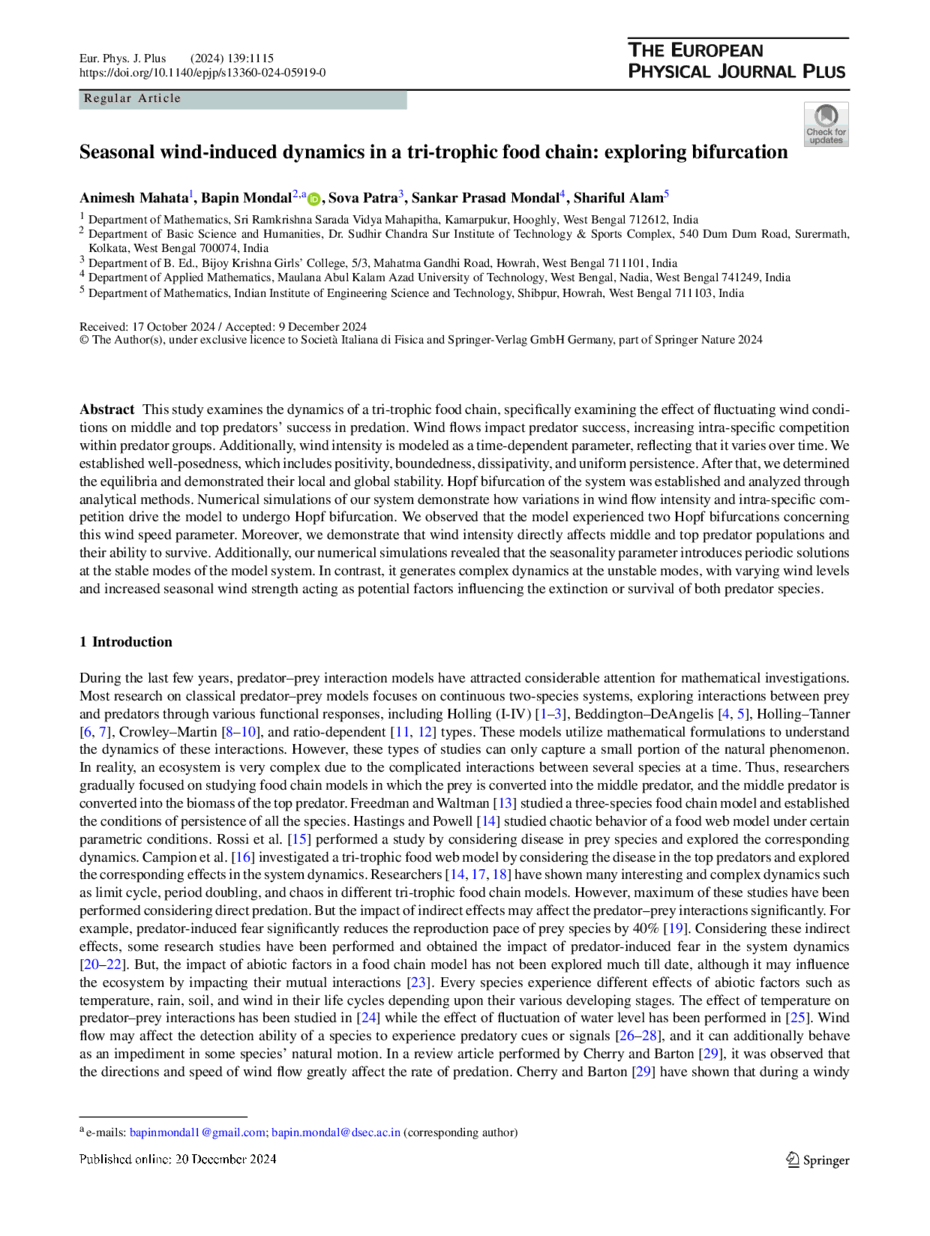https://doi.org/10.1140/epjp/s13360-024-05919-0
Regular Article
Seasonal wind-induced dynamics in a tri-trophic food chain: exploring bifurcation
1
Department of Mathematics, Sri Ramkrishna Sarada Vidya Mahapitha, Kamarpukur, 712612, Hooghly, West Bengal, India
2
Department of Basic Science and Humanities, Dr. Sudhir Chandra Sur Institute of Technology & Sports Complex, 540 Dum Dum Road, Surermath, 700074, Kolkata, West Bengal, India
3
Department of B. Ed., Bijoy Krishna Girls’ College, 5/3, Mahatma Gandhi Road, 711101, Howrah, West Bengal, India
4
Department of Applied Mathematics, Maulana Abul Kalam Azad University of Technology, West Bengal, 741249, Nadia, West Bengal, India
5
Department of Mathematics, Indian Institute of Engineering Science and Technology, Shibpur, 711103, Howrah, West Bengal, India
a bapinmondal1@gmail.com, bapin.mondal@dsec.ac.in
Received:
17
October
2024
Accepted:
9
December
2024
Published online:
20
December
2024
This study examines the dynamics of a tri-trophic food chain, specifically examining the effect of fluctuating wind conditions on middle and top predators’ success in predation. Wind flows impact predator success, increasing intra-specific competition within predator groups. Additionally, wind intensity is modeled as a time-dependent parameter, reflecting that it varies over time. We established well-posedness, which includes positivity, boundedness, dissipativity, and uniform persistence. After that, we determined the equilibria and demonstrated their local and global stability. Hopf bifurcation of the system was established and analyzed through analytical methods. Numerical simulations of our system demonstrate how variations in wind flow intensity and intra-specific competition drive the model to undergo Hopf bifurcation. We observed that the model experienced two Hopf bifurcations concerning this wind speed parameter. Moreover, we demonstrate that wind intensity directly affects middle and top predator populations and their ability to survive. Additionally, our numerical simulations revealed that the seasonality parameter introduces periodic solutions at the stable modes of the model system. In contrast, it generates complex dynamics at the unstable modes, with varying wind levels and increased seasonal wind strength acting as potential factors influencing the extinction or survival of both predator species.
Copyright comment Springer Nature or its licensor (e.g. a society or other partner) holds exclusive rights to this article under a publishing agreement with the author(s) or other rightsholder(s); author self-archiving of the accepted manuscript version of this article is solely governed by the terms of such publishing agreement and applicable law.
© The Author(s), under exclusive licence to Società Italiana di Fisica and Springer-Verlag GmbH Germany, part of Springer Nature 2024
Springer Nature or its licensor (e.g. a society or other partner) holds exclusive rights to this article under a publishing agreement with the author(s) or other rightsholder(s); author self-archiving of the accepted manuscript version of this article is solely governed by the terms of such publishing agreement and applicable law.





